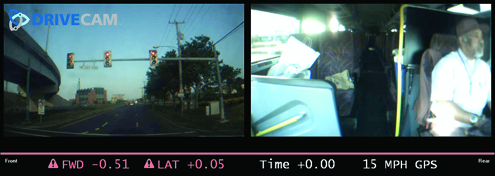

DriveCam lists its most dangerous behavior — and it’s not texting
By Del Lisk
In their effort to reduce bus and coach collisions, government, industry and trade associations publish lists of the most common risky driving behaviors which fleet operators then draw from to build their safety programs.
Unfortunately the methods for these studies are limiting, as the majority rely on data from accident reports, witness statements and law enforcement analysis. Although it is important to consider such resources, their perspectives are often incomplete and commonly skewed.
The most commonly cited risky driving behaviors include distracted driving, speeding, traveling too fast for conditions, fatigue, traffic law violations and aggressive driving.
The case for onboard video re-made
In-cab video technology remains one of the most reliable means for capturing the indisputable evidence of what really happened. It improves driver behavior and provides proof in the case of a collision.
The video event recorder affixed to the windshield captures inside views of the driver as well as the outside oncoming view. Substantial force, such as hard braking or swerving, triggers the device and saves the last eight seconds before the moment of force and the four seconds after. The net result is a visual record that reveals what happened and why.
With the video coverage uploaded to a review center for evaluation, the client receives notice of any events that might require further driver coaching through a web portal. DriveCam has analyzed more than 20 million risky driving events that have sharpened industry knowledge about driver behavior.
The value of video
DriveCam’s findings from commonly held beliefs — such as cell phone use and texting. In fact, the Department of Transportation has implemented stiff penalties for commercial drivers cited for using hand-held devices while behind the wheel, leaving commercial fleets to limit or prohibit their use.
There is no question drivers engaged in texting or dialing are driving blind, clueless to their surroundings. However, DriveCam data suggests that even if drivers do put down their cell phones, it will not have the impact most anticipate for reducing collisions, injuries and fatalities.
In a 2009 study, DriveCam found that those drivers who had one or more risky events involving a cell phone risked higher crash rate. However, risky driving events involving a cell represented less than five percent of all risky driving behaviors identified. This implies riskier behaviors that are getting overlooked — behaviors clearly revealed in the DriveCam data.
DriveCam is finding the most common risky behaviors are not products of new technologies. Instead, they relate to the fundamental skills that all drivers should have acquired. All too often drivers do not understand or recognize the risk.
The revised list of risky behaviors
Not looking far ahead —This behavior turns risky when a driver responds abruptly to a problem well after it becomes unmistakably visible. Late responses can lead to rear-ending the vehicle ahead, getting rear-ended from behind, passengers falling or load shifts damaging goods.
This risky behavior was present in 28 percent of the risky driving events that DriveCam reviewed. Findings show that drivers who repeatedly exhibit this behavior are more likely to have one or more collisions, as opposed to drivers not identified with this issue.
A recent 26-week DriveCam study revealed that a driver with five or more incidents of not looking far ahead is three times more likely to experience a collision.
Failure to keep an eye out — This is an instance where a driver unnecessarily cuts it too close to other vehicles, pedestrians or objects. Though observed in only 5 percent of risky events, researchers found that drivers with this behavior correlated significantly to increased collision potential. For example, a driver with five such events during the study period was five times more likely to have a collision than one with none of these events.
Following too close — Data shows that following cars at distances of less than two seconds is very risky. This was present in 27 percent of the risky events reviewed. Furthermore, a driver with five or more instances of following at a distance of one second or less was four times more likely to have experienced a crash than a driver with none of these events.
Driver safety efforts tend to go through periods where one issue reaches a critical mass in awareness and goes viral. This is beneficial in that it draws attention the issue and promotes change. However, it can also lull fleet operators into thinking they have solved the problem. Some may overlook other crucial safety issues and will be disappointed when they don’t realize their expected results.
Until technology can take driving decisions out of operators’ hands, driving safety efforts need to focus on ensuring drivers are using the fundamentals of safe driving. Vehicles and technology may have changed dramatically over the years, but the underlying causes for driving mistakes have not. BR
Del Lisk serves as director of safety services for DriveCam, San Diego, CA.
